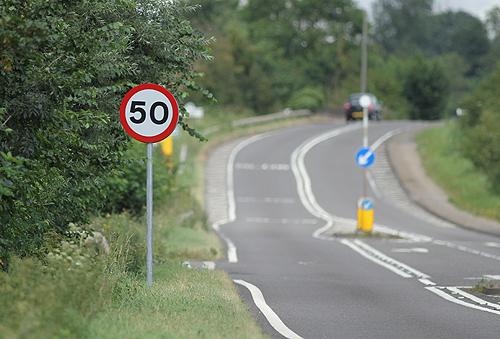But what does that really mean?
This is what 53m looks like in comparison to a standard saloon car (average length of 4m): 53m = approximately 13 standard cars

How realistic is this?
At 50mph, a vehicle is travelling at 22.35 metres per second (mps). Using the Highway Code’s 15m thinking time, a vehicle has just 1.7 seconds to stop.
To put this into context, it has taken approximately 8.6 seconds to read that sentence and in that time, you would have travelled 192m! 1.7 seconds isn’t a long time is it?
When we look at vans and heavy goods vehicles (HGVs), an additional factor must be taken into consideration - velocity. A standard car has just itself to stop, but in the majority of cases, both the van and HGV will be carrying (or towing) a load, which has a significant impact on the Highway Code’s figures.
A standard van requires an extra 33% braking distance, whilst an HGV requires a staggering 66% extra braking distance.
Ignoring the 33% means that normally, it would be 8 standard van lengths, however, in reality, it is 11.

That's 70m instead of 38m!
The additional 66% for HGVs increases the distance by 32m - an extra 2 standard HGV lengths.

That’s 88m instead of 38m!
We believe that the figures listed by the Highway Code are missing an important factor. A factor that actually replaces the 15m of thinking time, making a huge difference to the actual time required to stop.
We call it the ‘3-2-1 process’ - a 3-step process, in just 2 seconds and you have only 1 chance to get it right!
The 3 steps are as follows:
Step 1 = Perceive/Perception
This is where the driver notices that something unusual or out of ordinary is catching their attention.
Step 2 = Recognise/Recognition
This is where the driver becomes aware that they need to do something/take action.
Step 3 = Decide/Decision
This is where the driver decides on what that action is going to be.
These actions take 2 seconds minimum to carry out and have a massive impact on the figures mentioned above.
At 50mph, a vehicle travels at 22.35m per second, so in the ‘3-2-1 Process’, that vehicle will travel 44.70m, leaving just 8.3m (according to the Highway Code’s figures) to come to a complete stop.
In reality, the true stopping distance is, therefore, 82.7m (38m + 44.7m).
How does this affect the figures listed above? For the standard saloon car, this has increased from 13 to 20 standard cars. An extra 7 vehicles, 28m or 1.25 seconds!
For the standard van, this has increased from 11 to 18 standard vans. An extra 7 vehicles, 42m or 1.87 seconds!
For the standard 44-foot HGV, this has increased from 5 to 8 HGVs. An extra 3 vehicles, 48m or 2.14 seconds!
Why is this important?
The faster a vehicle is travelling, the less time the driver has to react, so the greater the chance of a crash happening.
In the process of braking, it is a recognised fact that a vehicle will lose the last 50% of its speed in the last 5m. This statistic is completely lost or unknown to the vast majority of drivers. Ultimately, this means that a vehicle travelling at 50mph only has half a second for the last 5m to lose its last 25mph.
What changes can we make?
Slow down? Speed is an important factor as we know, however even at 20mph, little time is left to come to a complete stop.
Better awareness of a possible hazard? If ‘we’ are the hazard, what are we doing to make sure ‘we’ are seen?
This ‘hazard’ is not necessarily just a stranded vehicle, it could be a parked HGV unloading goods. Whatever and wherever it is, if it’s on the road, then it’s a potential hazard and the driver has a responsibility to make other road users aware that it is there.
We believe the sooner a driver is made aware of a potential risk, the more time they will have to act on it.
The Briteangle LED Warning Triangle can be seen day or night from up to 300m, thus giving the driver of any approaching vehicle significantly more time to perceive, recognise and decide what to do.
Using what we have identified as the actual required stopping distances for 50mph, we see the following advantages of using the BriteAngle:

This is why the BriteAngle mantra is so important: ‘Be Seen - Be Safe’.
For more information on the advantages of the BriteAngle LED Warning Triangle, contact us at sales@roadsafetydesign.co.uk
